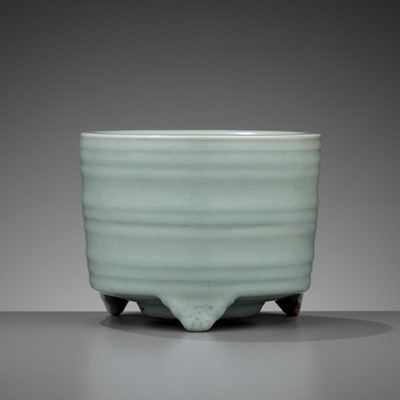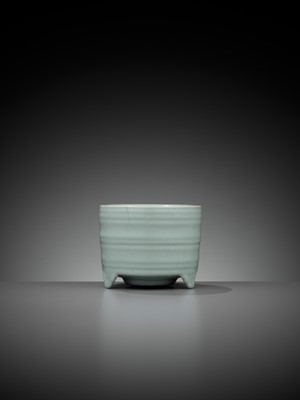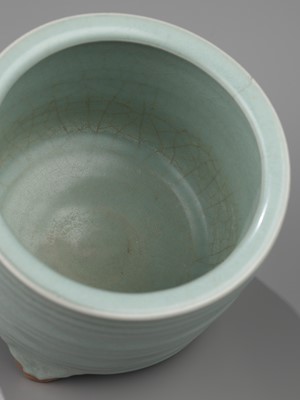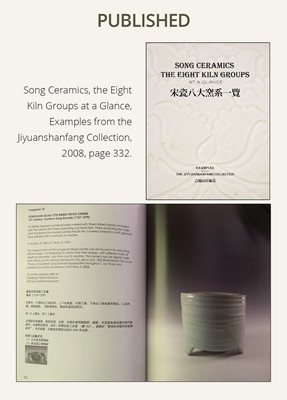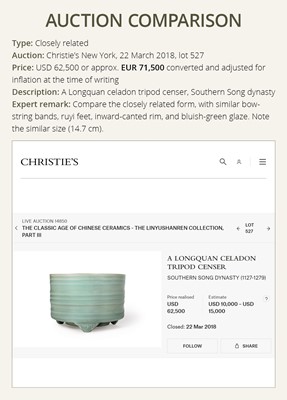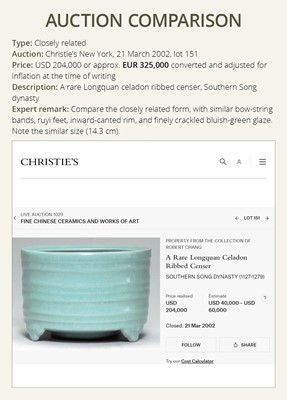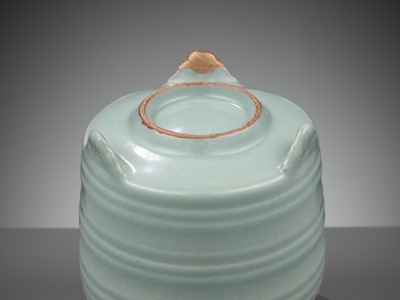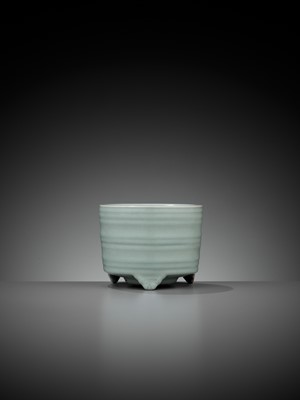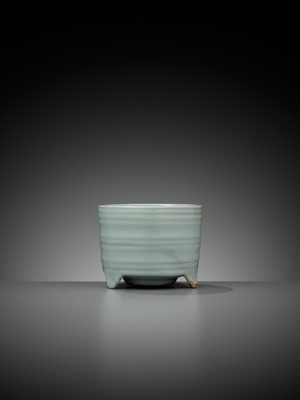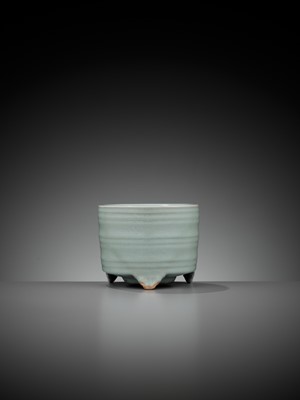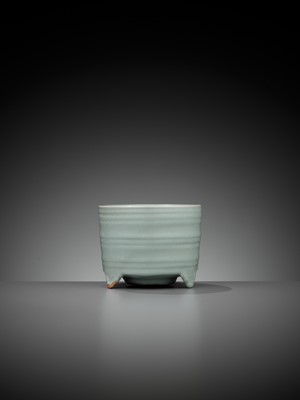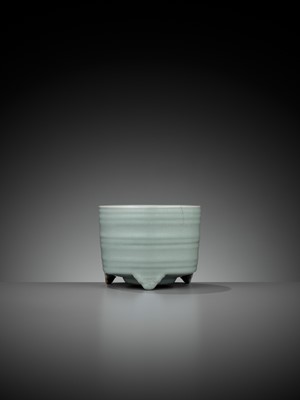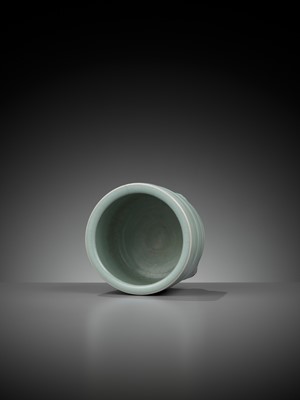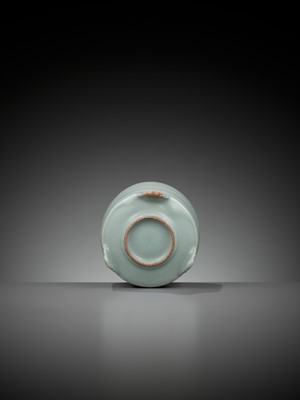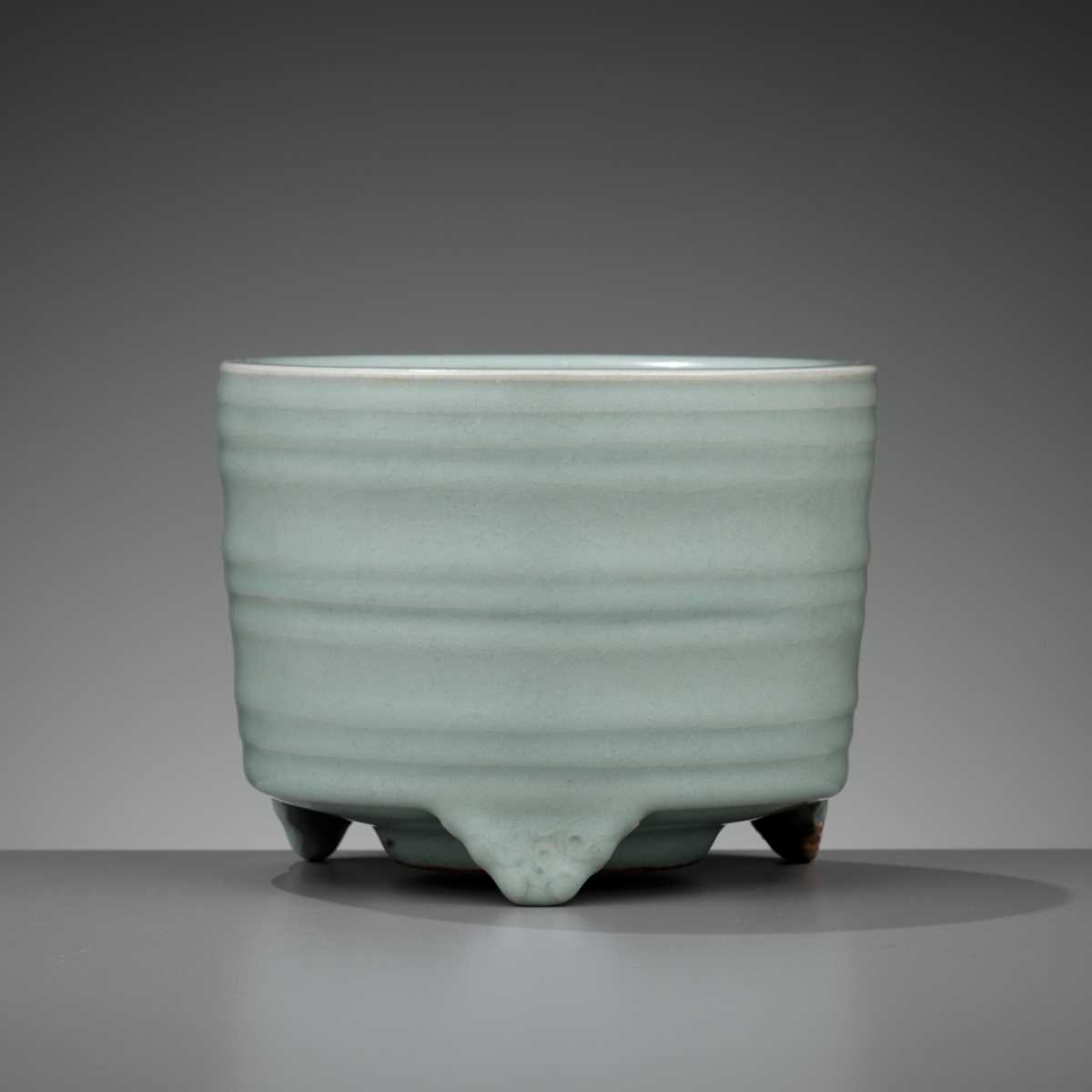9th Mar, 2023 13:00
TWO-DAY AUCTION - Fine Chinese Art / 中國藝術集珍 / Buddhism & Hinduism
78
A GUAN-TYPE LONGQUAN TRIPOD CENSER, LIAN, SOUTHERN SONG DYNASTY
南宋龍泉窯仿官釉弦紋三足爐
Sold for €15,600
including Buyer's Premium
Published: Song Ceramics, the Eight Kiln Groups at a Glance, Examples from the Jiyuanshanfang Collection, 2008, page 332.
China, 1127-1279. The cylindrical body is encircled by three sets of raised bow-string bands, comprised of two ribs above the three foliate-molded ruyi-head supports, three encircling the mid-body and three below the flat inward-canted mouth rim. The censer is covered overall with a rich, finely crackled, bluish-green glaze which thins slightly on the rim and raised decoration, the unglazed edge of the tapering rim on the underside burnt orange in the firing.
Provenance: The Jiyuanshanfang Collection. Currently housed on New York’s Upper East Side and originally founded upon an old family collection, a comprehensive catalog of the Jiyuanshanfang collection titled “Song Ceramics: The Eight Kiln Groups” was published in 2008 with a foreword written by Li Zhiyan, Research Fellow at the Beijing Palace Museum. Another contributor to this catalog was Martin Lorber, formerly Director of Sotheby’s New York. Jiyuanshanfang’s first exhibition was held in 2012 at the Morris Museum in New Jersey. In 2015, Jiyuanshanfang lent early Chinese ceramics to a large-scale exhibition at the Norton Museum of Art in Palm Beach, Florida, titled “High Tea: Glorious Manifestations – East and West”.
Condition: Good condition commensurate with age, showing expected old wear, traces of usage and shallow surface scratches. Some firing irregularities, the rim with a short hairline and associated microscopic loss, the foot rim with a tiny crack, one ruyi foot with an old kintsugi repair. The interior with remnants of calcification and russet discoloration to the crackle, consistent with temporary use as a jardinière.
Weight: 808.3 g
Dimensions: Diameter 14 cm
The shape of the present censer originates from archaic bronze lian vessels, which were among the ritual implements aimed to present food and drink offerings to the ancestors during the Han dynasty. This archaistic shape was also produced in the Ruyao glaze during the Northern Song period as exemplified in a related Ruyao tripod incense burner from the Qing Court collection, illustrated in The Complete Collection of Treasures of the Palace Museum: Porcelain of the Song Dynasty (I), Hong Kong, 1996, p. 2, no. 1. Ceramic vessels of this form are often molded with bow-strings around the body, such as the well-known Northern Song Ru censer in the Percival David Collection, illustrated in Sekai Toji Zenshu, vol. 12, Tokyo, 1977, p. 70, no. 62.
Expert’s note: The glaze on this censer is a particularly good example of the attractive bluish-green tone characteristic of the finest Longquan glazes of the guan type.
Literature comparison:
A closely related Longquan tripod censer, in the collection of the Hangzhou Archaeological Bureau, is illustrated by Zhu Boqian (ed.), Celadons from Longquan Kilns, Taipei, 1998, p. 149, no. 116. A small Longquan censer of similar form was discovered in 1991 in Suining, Sichuan province, amongst a cache of ceramics dating from the late Southern Song period, and is illustrated in Newly Discovered Southern Song Ceramics, A Thirteenth-Century “Time Capsule”, Tokyo, 1998, p. 32, no. 23.
Auction result comparison:
Type: Closely related
Auction: Christie’s New York, 22 March 2018, lot 527
Price: USD 62,500 or approx. EUR 71,500 converted and adjusted for inflation at the time of writing
Description: A Longquan celadon tripod censer, Southern Song dynasty
Expert remark: Compare the closely related form, with similar bow-string bands, ruyi feet, inward-canted rim, and bluish-green glaze. Note the similar size (14.7 cm).
Auction result comparison:
Type: Closely related
Auction: Christie’s New York, 21 March 2002, lot 151
Price: USD 204,000 or approx. EUR 325,000 converted and adjusted for inflation at the time of writing
Description: A rare Longquan celadon ribbed censer, Southern Song dynasty
Expert remark: Compare the closely related form, with similar bow-string bands, ruyi feet, inward-canted rim, and finely crackled bluish-green glaze. Note the similar size (14.3 cm).
南宋龍泉窯仿官釉弦紋三足爐
中國,1127-1279年。爐口沿較寬,直壁,圈足,足下承三個雲頭形足,三足與圈足在同一平面。器身凸起弦紋。通體施青釉,釉面開片,沿口略薄,圈足端無釉,呈橙色。
出版: 《宋瓷八大窯系一覽——吉緣山房藏品》,美國加州,2008年,頁332。
來源:吉緣山房收藏;美國知名私人收藏購於上述收藏。吉緣山房收藏坐落於紐約上東區,最初建立在一個古老的家庭收藏基礎之上。曾出版過《宋瓷八大窯系一覽——吉緣山房藏品》(美國加州,2008年)一書,北京故宮博物院李知宴做前言 。此畫冊的另一作者為Martin Lorber,紐約蘇富比前經理。吉緣山房收藏的第一個展覽是2012年在新澤西Morris Museum;2015年吉緣山房曾給佛羅裡達Norton Museum of Art出借過一批中國早期瓷器參加“High Tea: Glorious Manifestations – East and West” 展覽。
品相:品相良好,可見磨損與使用痕跡,表面有淺劃痕。一些燒製不規則現象,邊緣有短細裂紋和相關的細微缺損,足部邊緣有微小裂縫,一個如意足有金繼修復。內部有鈣化殘留物和裂紋的黃褐色變色,表明此器可能曾被用作花盆。
重量:808.3 g
尺寸:直徑14 厘米
本爐形制源於漢代青銅器禮器。這種仿古造型也曾在北宋時期的汝窯中出現,例如清宮收藏的汝窯鼎爐,見《故宮博物院藏文物珍品全集 – 兩宋瓷器》(上),香港,1996年,頁2,1號,此類弦紋爐還可見於Percival David收藏中的北宋汝窯爐,見《世界陶瓷全集》,第12冊,東京,1977年,頁70,62號。
專家注釋:此爐釉色極佳,盡顯上等龍泉官窯釉色澤迷人的青色調。
文獻比較:
一件非常相近的龍泉三足爐,收藏於Hangzhou Archaeological Bureau,見Zhu Boqian (ed.),《Celadons from Longquan Kilns》,臺北,1998年,頁149,編號116。一件較小的龍泉香爐,1991年出土於四川省遂寧市的一群南宋瓷器中,見《Newly Discovered Southern Song Ceramics,A Thirteenth-Century “Time Capsule”》,東京,1998年,頁32,編號23。
拍賣結果比較:
形制:非常相近
拍賣:紐約佳士得,2018年3月22日,lot 527
價格:USD 62,500(相當於今日EUR 71,500)
描述:南宋龍泉窯三足爐
專家評論:比較非常相近的外形、弦紋、如意足、內斜口和施青釉。請注意尺寸相似 (14.7 厘米)。
拍賣結果比較:
形制:非常相近
拍賣:紐約佳士得,2002年3月21日,lot 151
價格:USD 204,000(相當於今日EUR 325,000)
描述:南宋龍泉窯三足爐
專家評論:比較非常相近的外形、弦紋、如意足、內斜口和施青釉。請注意尺寸相似 (14.3 厘米)。
Published: Song Ceramics, the Eight Kiln Groups at a Glance, Examples from the Jiyuanshanfang Collection, 2008, page 332.
China, 1127-1279. The cylindrical body is encircled by three sets of raised bow-string bands, comprised of two ribs above the three foliate-molded ruyi-head supports, three encircling the mid-body and three below the flat inward-canted mouth rim. The censer is covered overall with a rich, finely crackled, bluish-green glaze which thins slightly on the rim and raised decoration, the unglazed edge of the tapering rim on the underside burnt orange in the firing.
Provenance: The Jiyuanshanfang Collection. Currently housed on New York’s Upper East Side and originally founded upon an old family collection, a comprehensive catalog of the Jiyuanshanfang collection titled “Song Ceramics: The Eight Kiln Groups” was published in 2008 with a foreword written by Li Zhiyan, Research Fellow at the Beijing Palace Museum. Another contributor to this catalog was Martin Lorber, formerly Director of Sotheby’s New York. Jiyuanshanfang’s first exhibition was held in 2012 at the Morris Museum in New Jersey. In 2015, Jiyuanshanfang lent early Chinese ceramics to a large-scale exhibition at the Norton Museum of Art in Palm Beach, Florida, titled “High Tea: Glorious Manifestations – East and West”.
Condition: Good condition commensurate with age, showing expected old wear, traces of usage and shallow surface scratches. Some firing irregularities, the rim with a short hairline and associated microscopic loss, the foot rim with a tiny crack, one ruyi foot with an old kintsugi repair. The interior with remnants of calcification and russet discoloration to the crackle, consistent with temporary use as a jardinière.
Weight: 808.3 g
Dimensions: Diameter 14 cm
The shape of the present censer originates from archaic bronze lian vessels, which were among the ritual implements aimed to present food and drink offerings to the ancestors during the Han dynasty. This archaistic shape was also produced in the Ruyao glaze during the Northern Song period as exemplified in a related Ruyao tripod incense burner from the Qing Court collection, illustrated in The Complete Collection of Treasures of the Palace Museum: Porcelain of the Song Dynasty (I), Hong Kong, 1996, p. 2, no. 1. Ceramic vessels of this form are often molded with bow-strings around the body, such as the well-known Northern Song Ru censer in the Percival David Collection, illustrated in Sekai Toji Zenshu, vol. 12, Tokyo, 1977, p. 70, no. 62.
Expert’s note: The glaze on this censer is a particularly good example of the attractive bluish-green tone characteristic of the finest Longquan glazes of the guan type.
Literature comparison:
A closely related Longquan tripod censer, in the collection of the Hangzhou Archaeological Bureau, is illustrated by Zhu Boqian (ed.), Celadons from Longquan Kilns, Taipei, 1998, p. 149, no. 116. A small Longquan censer of similar form was discovered in 1991 in Suining, Sichuan province, amongst a cache of ceramics dating from the late Southern Song period, and is illustrated in Newly Discovered Southern Song Ceramics, A Thirteenth-Century “Time Capsule”, Tokyo, 1998, p. 32, no. 23.
Auction result comparison:
Type: Closely related
Auction: Christie’s New York, 22 March 2018, lot 527
Price: USD 62,500 or approx. EUR 71,500 converted and adjusted for inflation at the time of writing
Description: A Longquan celadon tripod censer, Southern Song dynasty
Expert remark: Compare the closely related form, with similar bow-string bands, ruyi feet, inward-canted rim, and bluish-green glaze. Note the similar size (14.7 cm).
Auction result comparison:
Type: Closely related
Auction: Christie’s New York, 21 March 2002, lot 151
Price: USD 204,000 or approx. EUR 325,000 converted and adjusted for inflation at the time of writing
Description: A rare Longquan celadon ribbed censer, Southern Song dynasty
Expert remark: Compare the closely related form, with similar bow-string bands, ruyi feet, inward-canted rim, and finely crackled bluish-green glaze. Note the similar size (14.3 cm).
南宋龍泉窯仿官釉弦紋三足爐
中國,1127-1279年。爐口沿較寬,直壁,圈足,足下承三個雲頭形足,三足與圈足在同一平面。器身凸起弦紋。通體施青釉,釉面開片,沿口略薄,圈足端無釉,呈橙色。
出版: 《宋瓷八大窯系一覽——吉緣山房藏品》,美國加州,2008年,頁332。
來源:吉緣山房收藏;美國知名私人收藏購於上述收藏。吉緣山房收藏坐落於紐約上東區,最初建立在一個古老的家庭收藏基礎之上。曾出版過《宋瓷八大窯系一覽——吉緣山房藏品》(美國加州,2008年)一書,北京故宮博物院李知宴做前言 。此畫冊的另一作者為Martin Lorber,紐約蘇富比前經理。吉緣山房收藏的第一個展覽是2012年在新澤西Morris Museum;2015年吉緣山房曾給佛羅裡達Norton Museum of Art出借過一批中國早期瓷器參加“High Tea: Glorious Manifestations – East and West” 展覽。
品相:品相良好,可見磨損與使用痕跡,表面有淺劃痕。一些燒製不規則現象,邊緣有短細裂紋和相關的細微缺損,足部邊緣有微小裂縫,一個如意足有金繼修復。內部有鈣化殘留物和裂紋的黃褐色變色,表明此器可能曾被用作花盆。
重量:808.3 g
尺寸:直徑14 厘米
本爐形制源於漢代青銅器禮器。這種仿古造型也曾在北宋時期的汝窯中出現,例如清宮收藏的汝窯鼎爐,見《故宮博物院藏文物珍品全集 – 兩宋瓷器》(上),香港,1996年,頁2,1號,此類弦紋爐還可見於Percival David收藏中的北宋汝窯爐,見《世界陶瓷全集》,第12冊,東京,1977年,頁70,62號。
專家注釋:此爐釉色極佳,盡顯上等龍泉官窯釉色澤迷人的青色調。
文獻比較:
一件非常相近的龍泉三足爐,收藏於Hangzhou Archaeological Bureau,見Zhu Boqian (ed.),《Celadons from Longquan Kilns》,臺北,1998年,頁149,編號116。一件較小的龍泉香爐,1991年出土於四川省遂寧市的一群南宋瓷器中,見《Newly Discovered Southern Song Ceramics,A Thirteenth-Century “Time Capsule”》,東京,1998年,頁32,編號23。
拍賣結果比較:
形制:非常相近
拍賣:紐約佳士得,2018年3月22日,lot 527
價格:USD 62,500(相當於今日EUR 71,500)
描述:南宋龍泉窯三足爐
專家評論:比較非常相近的外形、弦紋、如意足、內斜口和施青釉。請注意尺寸相似 (14.7 厘米)。
拍賣結果比較:
形制:非常相近
拍賣:紐約佳士得,2002年3月21日,lot 151
價格:USD 204,000(相當於今日EUR 325,000)
描述:南宋龍泉窯三足爐
專家評論:比較非常相近的外形、弦紋、如意足、內斜口和施青釉。請注意尺寸相似 (14.3 厘米)。
Zacke Live Online Bidding
Our online bidding platform makes it easier than ever to bid in our auctions! When you bid through our website, you can take advantage of our premium buyer's terms without incurring any additional online bidding surcharges.
To bid live online, you'll need to create an online account. Once your account is created and your identity is verified, you can register to bid in an auction up to 12 hours before the auction begins.
Intended Spend and Bid Limits
When you register to bid in an online auction, you will need to share your intended maximum spending budget for the auction. We will then review your intended spend and set a bid limit for you. Once you have pre-registered for a live online auction, you can see your intended spend and bid limit by going to 'Account Settings' and clicking on 'Live Bidding Registrations'.
Your bid limit will be the maximum amount you can bid during the auction. Your bid limit is for the hammer price and is not affected by the buyer’s premium and VAT. For example, if you have a bid limit of €1,000 and place two winning bids for €300 and €200, then you will only be able to bid €500 for the rest of the auction. If you try to place a bid that is higher than €500, you will not be able to do so.
Online Absentee and Telephone Bids
You can now leave absentee and telephone bids on our website!
Absentee Bidding
Once you've created an account and your identity is verified, you can leave your absentee bid directly on the lot page. We will contact you when your bids have been confirmed.
Telephone Bidding
Once you've created an account and your identity is verified, you can leave telephone bids online. We will contact you when your bids have been confirmed.
Classic Absentee and Telephone Bidding Form
You can still submit absentee and telephone bids by email or fax if you prefer. Simply fill out the Absentee Bidding/Telephone bidding form and return it to us by email at office@zacke.at or by fax at +43 (1) 532 04 52 20. You can download the PDF from our Upcoming Auctions page.
How-To Guides
How to Create Your Personal Zacke Account
How to Register to Bid on Zacke Live
How to Leave Absentee Bids Online
How to Leave Telephone Bids Online
中文版本的操作指南
创建新账号
注册Zacke Live在线直播竞拍(免平台费)
缺席投标和电话投标
Third-Party Bidding
We partner with best-in-class third-party partners to make it easy for you to bid online in the channel of your choice. Please note that if you bid with one of our third-party online partners, then there will be a live bidding surcharge on top of your final purchase price. You can find all of our fees here. Here's a full list of our third-party partners:
- 51 Bid Live
- EpaiLive
- ArtFoxLive
- Invaluable
- LiveAuctioneers
- the-saleroom
- lot-tissimo
- Drouot
Please note that we place different auctions on different platforms. For example, in general, we only place Chinese art auctions on 51 Bid Live.
Bidding in Person
You must register to bid in person and will be assigned a paddle at the auction. Please contact us at office@zacke.at or +43 (1) 532 04 52 for the latest local health and safety guidelines.
